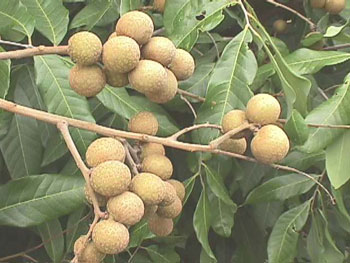| Propagation: 46 to 50 of 93 NextPage Go to Page: 1 2 3 4 5 6 7 8 9 10 11 12 13 14 15 16 17 18 19 | |

|
Longan
Botanical Name: Dimocarpus longan Longan can be propagated from seed, air-layering, budding, grafting, cutting and inarching. Trees grown from seeds take longer to bear fruit (7-8 years). The seeds lose viability quickly. After drying in the shade for 4 day, they should be planted without delay, but no more than 2 cm deep, otherwise they may send up more than one sprout. Germination takes place within a week or 10 days. |

|
Loquat
Botanical Name: Eriobotrya japonica Generally, seeds are used for propagation only when the tree is grown for ornamental purposes or for use as rootstock. Trees that are vegetatively propagated will begin to bear fruit in 5 years or less, as compared to 8 to 10 years in seedling trees. Old seedling trees can be converted by cutting back severely and inserting budwood of a preferred cultivar. |

|
Lychee
Botanical Name: Litchi chinensis Lychees do not reproduce faithfully from seed. Furthermore, lychee seeds remain viable only 4 to 5 days, and seedling trees will not bear until they are 5 to 12, or even 25, years old. For these reasons, seeds are planted mostly for selection and breeding purposes or for rootstock. Air-layering is the most common method of propagation. |

|
Macadamia
Botanical Name: Macadamia integrifolia Propagation from seed is relatively easy - the seed should be sown when fresh but the ree may not produce fruit for 8 - 12 years. Cuttings are also successful but vegetative propagation is usually carried out by grafting or budding of select forms onto seedlings. |

|
Mango
Botanical Name: Mangifera Indica Mango trees grow readily from seed however trees are mainly grafted to guarantee fruiting. The seed should be fresh, not dried. The flesh should be completely removed. Then the husk is opened by carefully paring around the convex edge with a sharp knife and taking care not to cut the kernel, which will slide out. Husk removal speeds germination and avoids cramping of roots. Finally, the husked kernels are treated with fungicide and planted without delay. The beds must have solid bottoms to prevent excessive taproot growth, otherwise the taproot will become 45-60 cm long while the top will be only one third to a half as high, and the seedling will be difficult to transplant with any assurance of survival. The seed is placed on its ventral (concave) edge with 1/4 protruding above the sand. Sprouting occurs in 8 to 14 days in a warm, tropical climate; 3 weeks in cooler climates. Seedlings generally take 6 years to fruit and 15 years to attain optimum yield. Grafted trees will fruit in 3 years. |
| 46 to 50 of 93 NextPage Go to Page: 1 2 3 4 5 6 7 8 9 10 11 12 13 14 15 16 17 18 19 | |